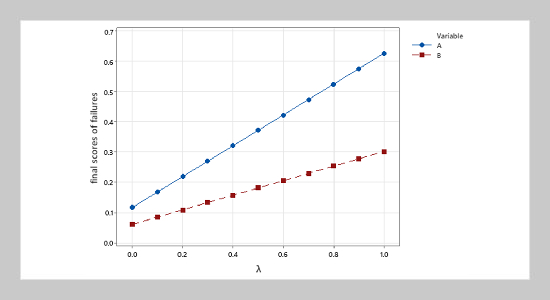- [1] B. Vahdani, M. Salimi, and M. Charkhchian, (2015) “A new FMEA method by integrating fuzzy belief structure and TOPSIS to improve risk evaluation process" The International Journal of Advanced Manufacturing Technology 77: 357–368. DOI: 10.1007/s00170-014-6466-3.
- [2] A. Ardeshir, M. Amiri, and M. Mohajeri, (2013) “Safety risk assessment in mass housing projects using com�bination of Fuzzy FMEA, Fuzzy FTA and AHP-DEA" Iran Occupational Health 10(6): 78–91.
- [3] J. Huang, J.-X. You, H.-C. Liu, and M.-S. Song, (2020) “Failure mode and effect analysis improvement: A system�atic literature review and future research agenda" Reli�ability Engineering & System Safety 199: 106885. DOI: 10.1016/j.ress.2020.106885.
- [4] D. Lijoi, M. Farina, A. Puppo, A. Novelli, and S. Ferrero, (2019) “Application of failure mode and effect analysis in total laparoscopic hysterectomy in benign con�ditions." Minerva ginecologica 71(4): 272–280. DOI: 10.23736/S0026-4784.19.04227-8.
- [5] S. Carpitella, A. Certa, J. Izquierdo, and C. M. La Fata, (2018) “A combined multi-criteria approach to support FMECA analyses: A real-world case" Reliability Engi�neering & System Safety 169: 394–402. DOI: 10.1016/j.ress.2017.09.017.
- [6] P.-S. Chen and M.-T. Wu, (2013) “A modified failure mode and effects analysis method for supplier selection problems in the supply chain risk environment: A case study" Computers & Industrial Engineering 66(4): 634–642. DOI: 10.1016/j.cie.2013.09.018.
- [7] Y. Du, H. Mo, X. Deng, R. Sadiq, and Y. Deng, (2014) “A new method in failure mode and effects analysis based on evidential reasoning" International Journal of System Assurance Engineering and Management 5: 1–10. DOI: 10.1007/s13198-014-0218-5.
- [8] N. R. Sankar and B. S. Prabhu, (2001) “Modified ap�proach for prioritization of failures in a system failure mode and effects analysis" International Journal of Quality & Reliability Management 18(3): 324–336. DOI: 10.1108/02656710110383737.
- [9] A. Azadeh, M. Sheikhalishahi, and A. Aghsami, (2015) “An integrated FTA-DFMEA approach for reli�ability analysis and product configuration considering warranty cost" Production Engineering 9: 635–646. DOI: 10.1007/s11740-015-0642-7.
- [10] B. Ashtiani, F. Haghighirad, A. Makui, and G. ali Montazer, (2009) “Extension of fuzzy TOPSIS method based on interval-valued fuzzy sets" Applied Soft Com�puting 9(2): 457–461. DOI: 10.1016/j.asoc.2008.05.005.
- [11] M. Dehghan-Bonari and J. Heydari, (2022) “How a novel option contract helps a green product to enter a traditional product’s retailing channel: A mathematical modeling approach" Journal of Retailing and Con�sumer Services 69: 103090. DOI: 10.1016/j.jretconser.2022.103090.
- [12] A. C. Kutlu and M. Ekmekçio˘glu, (2012) “Fuzzy failure modes and effects analysis by using fuzzy TOPSIS-based fuzzy AHP" Expert systems with applications 39(1): 61–67. DOI: 10.1016/j.eswa.2011.06.044.
- [13] M. M. Koksalan, J. Wallenius, and S. Zionts. Multiple criteria decision making: from early history to the 21st century. World Scientific, 2011. DOI: 10.1142/8042.
- [14] M. Alipour-Vaezi, A. Aghsami, and M. Rabbani, (2022) “Introducing a novel revenue-sharing contract in media supply chain management using data mining and multi-criteria decision-making methods" Soft Comput�ing 26(6): 2883–2900. DOI: 10.1007/s00500-021-06609-0.
- [15] T.-Y. Chen, (2016) “An interval-valued intuitionistic fuzzy permutation method with likelihood-based prefer�ence functions and its application to multiple criteria deci�sion analysis" Applied Soft Computing 42: 390–409. DOI: 10.1016/j.asoc.2016.02.006.
- [16] Z. Mohammadnazari, M. Mousapour Mamoudan, M. Alipour-Vaezi, A. Aghsami, F. Jolai, and M. Yazdani, (2022) “Prioritizing post-disaster reconstruction projects using an integrated multi-criteria decision-making ap�proach: A case study" Buildings 12(2): 136. DOI: 10.3390/buildings12020136.
- [17] R. Tavakkoli-Moghaddam, M. Alipour-Vaezi, and Z. Mohammad-Nazari. “A new application of coordina�tion contracts for supplier selection in a cloud envi�ronment”. In: Advances in Production Management Sys�tems. Towards Smart and Digital Manufacturing: IFIP WG 5.7 International Conference, APMS 2020, Novi Sad, Serbia, August 30–September 3, 2020, Proceedings, Part II. Springer. 2020, 197–205. DOI: 10.1007/978-3-030- 57997-5_23.
- [18] E. K. Zavadskas, Z. Turskis, J. Antucheviciene, and A. Zakarevicius, (2012) “Optimization of weighted ag�gregated sum product assessment" Elektronika ir elek�trotechnika 122(6): 3–6. DOI: 10.5755/j01.eee.122.6.1810.
- [19] R. Džiugaite-Tum ˙ enien ˙ e and V. Lapinskien ˙ e, (2014) ˙ “The multicriteria assessment model for an energy supply system of a low energy house" Engineering Structures and Technologies 6(1): 33–41.
- [20] M. K. Ghorabaee, E. K. Zavadskas, M. Amiri, and A. Esmaeili, (2016) “Multi-criteria evaluation of green suppliers using an extended WASPAS method with inter�val type-2 fuzzy sets" Journal of Cleaner Production 137: 213–229. DOI: 10.1016/j.jclepro.2016.07.031.
- [21] F. Ebadzadeh, S. M. Monavari, S. A. Jozi, M. Robati, and R. Rahimi, (2023) “An integrated of fuzzy-WASPAS and E-FMEA methods for environmental risk assess�ment: A case study of petrochemical industry, Iran" En�vironmental Science and Pollution Research 30(14): 40315–40326. DOI: 10.1007/s11356-022-25088-w.
- [22] A. Kamali, A. Bozorgi-Amiri, and H. Shakibaei, (2020) “Risk Assessment and Ranking through Integra�tion Failure Mode and Effects Analysis and Multiple�Criteria Decision-Making in an Interval Valued Fuzzy Environment: A Case Study in Hydraulic Pump Indus�try" Journal of Occupational Hygiene Engineering Volume 7(1): 1–10.
- [23] A. Ijadi Maghsoodi, G. Abouhamzeh, M. Khalilzadeh, and E. K. Zavadskas, (2018) “Ranking and selecting the best performance appraisal method using the MULTIMOORA approach integrated Shannon’s entropy" Frontiers of Business Research in China 12: 1–21. DOI: 10.1186/s11782-017-0022-6.
- [24] B. M. Dos Santos, L. P. Godoy, and L. M. Campos, (2019) “Performance evaluation of green suppliers using entropy-TOPSIS-F" Journal of cleaner production 207: 498–509. DOI: 10.1016/j.jclepro.2018.09.235.
- [25] N.-C. Hsieh, L.-P. Hung, C.-C. Shih, H.-C. Keh, and C.-H. Chan, (2012) “Intelligent postoperative morbidity prediction of heart disease using artificial intelligence tech�niques" Journal of medical systems 36: 1809–1820. DOI: 10.1007/s10916-010-9640-7.
- [26] M. Alipour Vaezi and R. Tavakkoli-Moghaddam, (2020) “A new methodology for COVID-19 preparedness centers based on a location-allocation platform" Journal of Industrial and Systems Engineering 13(1): 35–41.
- [27] W. Gilchrist, (1993) “Modelling failure modes and effects analysis" International Journal of Quality & Reliability Management 10(5): DOI: 10.1108/02656719310040105.
- [28] Y.-M. Wang, K.-S. Chin, G. K. K. Poon, and J.-B. Yang, (2009) “Risk evaluation in failure mode and effects anal�ysis using fuzzy weighted geometric mean" Expert sys�tems with applications 36(2): 1195–1207. DOI: 10.1016/j.eswa.2007.11.028.
















